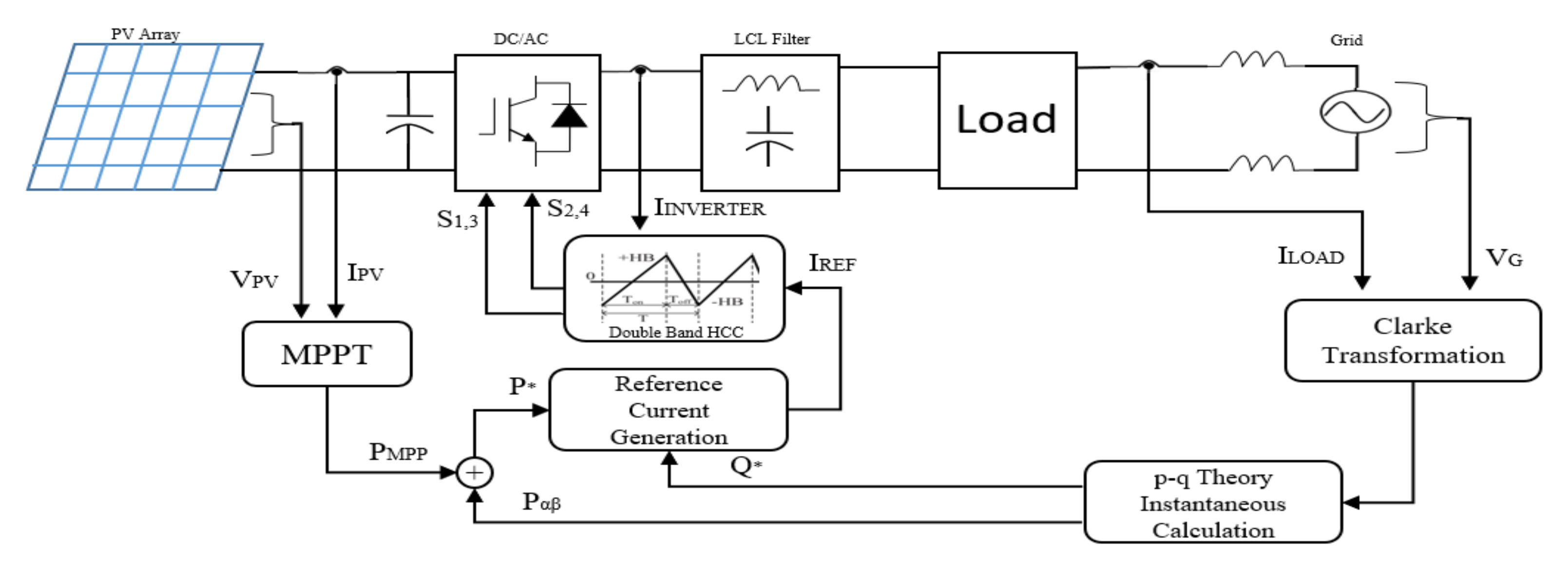An Improved Control Strategy for Single-Phase Single-Stage Grid-Tied PV System Based on Incremental Conductance MPPT, Modified PQ Theory, and Hysteresis Current Control †
Abstract
:1. Introduction
2. Methodology of Proposed Controller
3. Results and Discussion
4. Conclusions
Institutional Review Board Statement
Informed Consent Statement
Data Availability Statement
Conflicts of Interest
References
- Rezwan, S.; Bhavani, R. Power Quality Improvement of Single Phase Grid Connected Photo Voltaic System Master Of Technology Power Quality Improvement Of Single Phase Grid Connected Master of Technology. Electr. Power Syst. Res. 2018, 2018, 193–203. [Google Scholar]
- Dash, A.R.; Panda, A.K.; Penthia, T.; Dhal, P.K. Implementation of improved pq theory in shunt active filter based on cascaded multilevel inverter with single excited DC source. IEEMA Eng. Infin. Conf. eTechNxT 2018, 22, 1–6. [Google Scholar]
- Zafar, S.; Amin, M.A.; Javaid, B.; Khalid, H.A. On Design of DC-Link Voltage Controller and PQ Controller for Grid Connected VSC for Microgrid Application. In Proceedings of the 4th International Conference on Power Generation Systems and Renewable Energy Technologies, PGSRET 2018, Islamabad, Pakistan, 10–12 September 2018; pp. 10–12. [Google Scholar]
- Shaikh, F.; Joseph, B. Simulation of synchronous reference frame PLL for grid synchronization using Simulink. In Proceedings of the 2017 International Conference on Advances in Computing, Communication and Control, ICAC3 2017, Mumbai, India, 1–2 December 2017; pp. 1–6. [Google Scholar]
- Datta, A.; Sarker, R.; Hazarika, I. An Efficient Technique Using Modified p–q Theory for Controlling Power Flow in a Single-Stage Single-Phase Grid-Connected PV System. IEEE Trans. Ind. Inform. 2019, 15, 4635–4645. [Google Scholar] [CrossRef]
- Dasgupta, S.; Sahoo, S.K.; Panda, S.K. A novel current control scheme using Lyapunov function to control the active and reactive power flow in a single phase hybrid PV inverter system connected to the grid. In Proceedings of the 2010 International Power Electronics Conference—ECCE Asia, IPEC 2010, Sapporo, Japan, 21–24 June 2010; pp. 1701–1708. [Google Scholar]
- Sujatha, B.; Anitha, G. Enhancement of PQ in grid connected PV system using hybrid technique. Ain Shams Eng. J. 2018, 9, 869–881. [Google Scholar] [CrossRef] [Green Version]
- Tarasantisuk, C.; Kumsup, S.; Piyarat, W.; Witheepanich, K. Stationary frame current regulation using Proportional Resonant controller for single phase grid connected inverter. In Proceedings of the 2016 13th International Conference on Electrical Engineering/Electronics, Computer, Telecommunications and Information Technology, ECTI-CON 2016, Piscataway, NJ, USA, 28 June 2016–1 July 2016. [Google Scholar]
- Nikroo, M.; Montazeri, S.H.; Milimonfared, J.; Shadian, F. Performance Analysis of Model Predictive Controller for Grid-Connected Quasi Z-Source and Split-Source PV Inverters. In Proceedings of the 2020 11th Power Electronics, Drive Systems, and Technologies Conference (PEDSTC), PEDSTC 2020, Tehran, Iran, 4–6 February 2020; pp. 1–6. [Google Scholar]
- Sorte, P.K.; Panda, K.P.; Peesapati, R.; Panda, G. An Improved Control Strategy for Single-Phase Single-Stage Grid-Tied PV System with Current Reference MPPT Control. In Proceedings of the 2020 IEEE International Conference on Computing, Power and Communication Technologies (GUCON), GUCON 2020, Greater Noida, UP, India, 2–4 October 2020; pp. 461–466. [Google Scholar]


| DC Link Capacitor | LCL Filter | Grid Inductance | Switching Frequency |
|---|---|---|---|
| 600 µF | LF1,2 = 3 mH, CF = 1 µF | LG1,2 = 10 mH | 10 kHz |
| Irradiance (W/m2), Temp (°C) | PPV (Watts) | PINVERTER (Watts) | QINVERTER (VAR) | PGRID (Watts) | QGRID (VAR) | THDi Load (%) |
|---|---|---|---|---|---|---|
| 0, 25 | 0 | 20.71 | 14.66 | −390 | −277 | 0.5 |
| 800, 25 | 372 | 368 | 261.60 | −1 | 0.99 | |
| 1000, 25 | 465 | 460 | 327 | 91 | 65 |
Publisher’s Note: MDPI stays neutral with regard to jurisdictional claims in published maps and institutional affiliations. |
© 2022 by the authors. Licensee MDPI, Basel, Switzerland. This article is an open access article distributed under the terms and conditions of the Creative Commons Attribution (CC BY) license (https://creativecommons.org/licenses/by/4.0/).
Share and Cite
Yusof, N.F.M.; Ishak, D.; Salem, M. An Improved Control Strategy for Single-Phase Single-Stage Grid-Tied PV System Based on Incremental Conductance MPPT, Modified PQ Theory, and Hysteresis Current Control. Eng. Proc. 2021, 12, 91. https://doi.org/10.3390/engproc2021012091
Yusof NFM, Ishak D, Salem M. An Improved Control Strategy for Single-Phase Single-Stage Grid-Tied PV System Based on Incremental Conductance MPPT, Modified PQ Theory, and Hysteresis Current Control. Engineering Proceedings. 2021; 12(1):91. https://doi.org/10.3390/engproc2021012091
Chicago/Turabian StyleYusof, Nur Fairuz Mohamed, Dahaman Ishak, and Mohamed Salem. 2021. "An Improved Control Strategy for Single-Phase Single-Stage Grid-Tied PV System Based on Incremental Conductance MPPT, Modified PQ Theory, and Hysteresis Current Control" Engineering Proceedings 12, no. 1: 91. https://doi.org/10.3390/engproc2021012091
APA StyleYusof, N. F. M., Ishak, D., & Salem, M. (2021). An Improved Control Strategy for Single-Phase Single-Stage Grid-Tied PV System Based on Incremental Conductance MPPT, Modified PQ Theory, and Hysteresis Current Control. Engineering Proceedings, 12(1), 91. https://doi.org/10.3390/engproc2021012091







